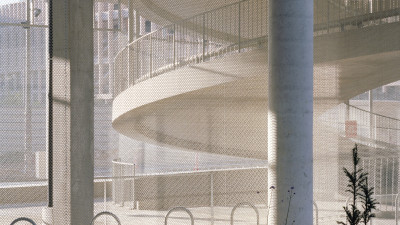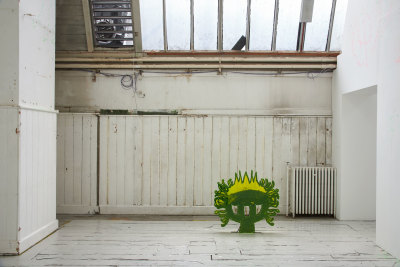Guggenheim Bilbao celebrates 20 years
Guggenheim Bilbao celebrates 20 years
By Sam Phillips
Published 18 November 2014
Two decades ago the paperwork for Guggenheim Bilbao was signed and sealed. We review the expansive exhibition that honours this landmark for an iconic institution.
-
It’s been 20 years since signatures were inked on the agreement to build the Guggenheim Bilbao. The museum’s anniversary exhibition Art of our Time – bringing together highlights from Solomon R. Guggenheim Foundation with works more recently acquired by the Spanish institution – has given the media the opportunity to debate how Frank Gehry Hon RA’s magnum opus has “changed the cultural landscape of the world”, in the words of the Foundation’s director Richard Armstrong at the show’s press launch. The ‘Guggenheim effect’ has become a stock recipe for urban regeneration, its key ingredient being a museum designed in such style by a starchitect that it becomes a destination in itself for tourists.
But the art inside does – of course – also matter, and however spectacular Gehry’s metal and glass structure is, appearing like a titanic amphibian rising out of the Ría Nervión, it is the high quality of loan exhibitions (a Georges Braque retrospective closed in September) and the permanent masterpieces on display (such as The Matter of Time, the breathtaking installation of steel by Richard Serra Hon RA) that makes visiting Bilbao an essential notch on any culture vulture’s belt. It will be interesting to see whether the American architect’s latest major building – the Fondation Louis Vuitton in Paris, which has just opened – exerts the same significance in terms of cultural tourism with its contents, according to some critics, of more questionable quality.
-

Vasily Kandinsky, Composition 8 (Komposition 8), July 1923.
Oil on canvas. 140 × 201 cm. Solomon R. Guggenheim Museum, New York, Solomon R. Guggenheim Founding Collection, By gift 37.262.
-
Does Art of our Time represent the perfect time to pay a pilgrimage? The exhibition’s first room is certainly something special for non-New Yorkers, as it displays a selection of world-class works from across the Atlantic that represent the Guggenheim’s ‘founding collection’. The first pre-war purchases were explorations in abstraction – so many that the collection’s first venue in 1939 was called the ‘Museum of Non-Objective Painting’. So one can enjoy some kaleidoscopic Kandinskys in this show (as the first director was obsessed with the Russian-born abstractionist) as well as strong, representative works by artists such as Chagall, Robert Delaunay, Mondrian, Marc and Picasso. The latter’s still life from 1931 is a particular knockout, reminding me, in the way he blends objects and architecture, why the Spanish artist’s name is a synonym for artistic genius.
-

Sol LeWitt, Wall Drawing #831 (Geometric Forms), 1997.

Eduardo Chillida, How Profound Is the Air (Lo profundo es el aire), 1996.
-
The post-war era is covered by the Guggenheim Bilbao’s acquisitions. After some singular works by Rothko and co, there is a floor that features four paintings by Anselm Kiefer Hon RA, series of works by both Baselitz and Twombly, and a wonderful Rauschenberg. A Sol LeWitt wall work, designed for the museum’s opening show in 1997, is reprised in a highly dramatic curved space. Most exquisite is a circular room dedicated to the Basque sculptor Eduardo Chillida Hon RA, who shaped metal and stone in a way that recalls architecture – this space, like many in the museum, benefits from natural light that falls through attractive apertures in Gehry’s structure.
-

Ragnar Kjartansson, The Visitors (The Visitors), 2012.
Nine channel HD video projection. Duration: 64 minutes. © Ragnar Kjartansson. Courtesy of the artist, Luhring Augustine, New York, and i8 Gallery, Reykjavik. Photo: Elísabet Davids.
-
It’s on the final floor where the exhibition’s subtitle, ‘Masterpieces from the Guggenheim Collections’, starts to wear thin. The displays try to capture 21st-century contemporary art – international in origin, plural in media – but there are few memorable pieces, and works such as a China Log (2005) by Ai Weiwei Hon RA, a tree trunk cut through with a map of China, are there to represent a master more than being a masterpiece in themselves. An exception can be enjoyed in the Film and Video space, in which Ragnar Kjartansson’s majestic video installation The Visitors (2012) is on view. The Icelandic artist and his musician friends performed an hour-long song in a historic house, except they sang or played their instruments in different rooms; the nine screens document their separate contributions (Kjartansson plays guitar in a bath of water), but the audio collects them together for our ears, and the result is a mesmeric piece about both individual and social experience.
The Art of Our Time: Masterpieces from the Guggenheim Collection Guggenheim Bilbao, until 25 January 2015 (Third Floor), until 3 May (First and Second Floors).







